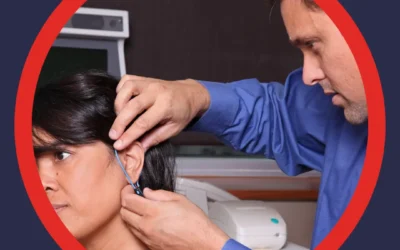Experiencing sounds differently in each ear can be unsettling. This phenomenon, known as diplacusis, exemplifies how strange hearing issues can be. Let’s explore diplacusis, its causes, symptoms, and potential solutions.
What is Diplacusis?
Diplacusis, or “double-hearing,” occurs when one ear perceives sounds differently from the other. This can result from damage to the hair cells in the inner ear that send signals to the auditory nerve. Medically, professionals explain it as the “perceptual anomaly whereby the same sound is perceived as having a different pitch depending on whether it is presented in the left or the right ear.”
This disturbing sensation can affect anyone but is most common in those with hearing loss in one ear or who are starting to lose their hearing.

The Symptoms of Diplacusis
Experiencing diplacusis can be unsettling and disruptive. Here are the common symptoms:
- Off-Pitch Hearing: Sounds may seem out of tune or distorted in one ear compared to the other. This can be particularly noticeable when listening to music or familiar voices.
- Echoes: You might hear echoes where there shouldn’t be any, making it feel like sounds are reverberating unnaturally. This can be confusing and make it difficult to understand conversations.
- Timing Discrepancies: Sounds may reach each ear at slightly different times. This can create a disjointed auditory experience, where sounds seem to lag or arrive at different moments, disrupting the natural flow of hearing.
Types of Diplacusis
Understanding the types of diplacusis helps in identifying and managing the condition more effectively. Here are the main types:
Diplacusis Monauralis:
Description: This type affects one ear, causing it to hear the same sound as two distinct sounds.
Experience: Imagine hearing a single note from a piano, but in one ear, it sounds like two different notes being played simultaneously. This can make it challenging to discern the true nature of sounds.
Diplacusis Binauralis:
Description: This type involves hearing the same sound differently in each ear. We can break it into two subtypes:
Diplacusis Dysharmonica:
Description: People perceive sounds at different pitches in each ear.
Experience: If you are listening to someone speak, one ear might hear their voice at a higher pitch while the other hears it at a lower pitch. This pitch discrepancy can make it difficult to understand speech clearly.
Diplacusis Echoica:
Description: Sounds are heard at different times in each ear, creating an echo effect.
Experience: When listening to a song, one ear might perceive the music slightly delayed compared to the other ear. This can result in an echo-like sensation, making it hard to enjoy music or follow conversations.
By recognizing these symptoms and understanding the types of diplacusis, individuals can better communicate their experiences to healthcare professionals, leading to more effective diagnosis and treatment.
Find out more about audiograms, the first step in effective diagnosis.
Why Do I Hear Double Sounds in My Ears?
Diplacusis is a symptom indicating a potential issue with your hearing system. Here are some common causes:
- Hearing Loss: Uneven hearing sensitivity between ears can lead to diplacusis.
- Ear Infections: Fluid buildup in the middle ear can disrupt sound transmission.
- Head Trauma: Injuries can damage hair cells in the inner ear.
- Medications: Some ototoxic medications can affect hearing.
- Meniere’s Disease: This inner ear disorder can cause fluctuating hearing loss and diplacusis
Find out more about ototoxic medications and hearing loss.
Does Diplacusis Go Away?
The persistence of diplacusis largely depends on its underlying cause.
- Temporary Causes: Ear infections can be healed, and medication side effects can be alleviated.
- Permanent Causes: Age-related hearing loss and inner ear damage may result in persistent diplacusis.
Even if diplacusis persists, management options exist to alleviate symptoms.
Finding Solutions: Living with Diplacusis
Addressing diplacusis involves treating the underlying cause and managing the symptoms. Here are detailed approaches:
Treating the Underlying Cause:
- Ear Infections: If an ear infection is causing your diplacusis, a doctor will prescribe antibiotics to clear the infection. This treatment helps drain fluid from the middle ear, restoring standard sound transmission and eliminating diplacusis.
- Medication Adjustments: If certain medications are responsible, discussing alternatives with your doctor is crucial. Switching to a different medication can resolve the hearing changes, including diplacusis.
- Hearing Loss: Hearing aids can be incredibly effective for hearing loss cases. These devices amplify sounds and provide a more balanced auditory experience. An audiologist can customize the settings to address specific pitch discrepancies, helping to reduce the perception of double hearing.
Managing Diplacusis:
- Focusing on the “Good” Ear: Aural rehabilitation therapy can train your brain to rely more on the ear for better hearing. This focus can help minimize the impact of the affected ear, improving overall hearing clarity.
- Sound Therapy: It can be beneficial to use background noise to mask the perception of double sounds. Sound therapy might involve white noise machines or specific sound generators that create a consistent background hum, making it easier to ignore the distracting effects of diplacusis.
- Hearing Aids: Modern hearing aids come with advanced features like directional microphones and frequency shaping. Your hearing care provider can program them to address the specific needs of someone with diplacusis, providing real-time adjustments to enhance sound quality and reduce double hearing.

Regular Monitoring and Professional Support:
- Audiological Interventions: Regular check-ups with an audiologist ensure that any changes in hearing abilities are promptly addressed. Audiologists can adjust hearing aid settings and provide counseling to help individuals cope with diplacusis.
- Patient Education: Understanding diplacusis and learning coping strategies can significantly improve one’s ability to adapt to this condition. Education on communication techniques and auditory training exercises can empower patients to handle various listening environments effectively.
When to See a Hearing Specialist
Consulting a hearing professional is crucial if you experience any hearing concerns, especially symptoms of diplacusis. An audiologist or ENT specialist can diagnose the cause and recommend a personalized treatment plan. This plan might involve addressing the underlying issue and managing diplacusis with sound therapy, hearing aids, or a combination of these approaches.
Don’t let diplacusis disrupt your life. Contact American Hearing + Audiology for a free evaluation. Our experts can help diagnose and manage your hearing issues, ensuring you receive the best care for your auditory health.



